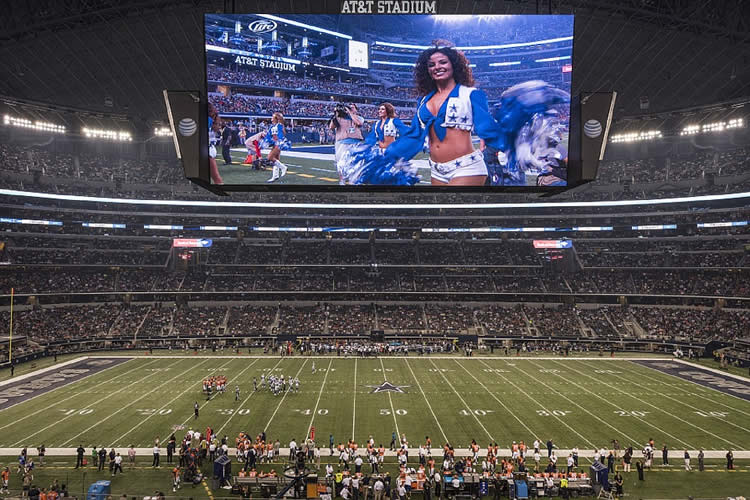Summary: A new study reports NFL teams perform better during night time games, thanks to a circadian advantage. Winning teams who play late evening games have fewer turnovers and players had better circadian regulated awareness than those who play in afternoon games, researchers report.
Source: AASM.
Pilot data from a recent study suggest that NFL teams have better performance during night games versus afternoon games due to advantages from circadian rhythms.
It is well established that NFL teams on the West Coast win more night games, dating back to the 1970s. Recent data conclude that the night game advantage for West Coast teams is due to fewer regular season injuries to linemen. This study expanded upon these historical data sets to determine additional factors producing a circadian advantage in performance due to season schedules.
Results show that winning teams had a circadian-dependent advantage of fewer turnovers. Winning teams had fewer turnovers during late evening games starting at 8 p.m. or 9 p.m. Eastern time, representing an upswing of circadian-regulated alertness, compared to afternoon games starting at 1 p.m. or 4 p.m. Eastern time, representing a downswing of circadian-regulated alertness.
“Based on what we know from decades of research on circadian rhythms of alertness and performance, we were expecting these data to explain why NFL teams win more games at night,” said principal investigator and senior author Allison Brager, PhD. She is an active duty Army scientist stationed at Walter Reed Army Institute of Research (WRAIR) in Silver Spring, Maryland, where she conducts sleep and performance research for the Behavioral Biology Branch under the Center for Neuroscience and Military Psychiatry.
“We were not expecting that the largest influence on game outcomes at night compared to the afternoon would arise from mental errors in play and injury,” Brager added. “We grossly underestimated the impact that circadian rhythms have on risk for injury in athletes.”
Human performance response curves were generated based on biological time for points scored, yards gained, and the number of turnovers for each of the 32 NFL teams during the 2013 regular season. The response curves compared changes in the performance metrics relative to biological time (normalized to Eastern time). A simple analysis of performance statistics plotted across an individual’s (or team’s) biological time captured daily rhythms of physical capabilities, risks for injury, and mental lapses in the real-world performance.

Game time did not change the extent of points scored and yards gained for winning or losing teams. As Brager expected, winning teams scored more points (11.3 + 0.1 spread) and gained more yards (40.7 yd + 0.2 spread) than losing teams.
According to Brager, these analyses support the observation that the circadian timing system exerts significant influence on performance metrics of professional sporting teams independent of talent, geography, and home field advantage. For this reason, Brager suggests that appropriate countermeasures may need to be implemented to counteract circadian-regulated influences on game day statistics.
Source: Corinne Lederhouse – AASM
Publisher: Organized by NeuroscienceNews.com.
Image Source: NeuroscienceNews.com image is in the public domain.
Original Research: The study “Use Of Human Performance Response Curves To Demonstrate Circadian Advantages For Teams Playing Night Games Across A National Football League Season” by Choynowski J, Skeiky L, St Pierre M, Brager A will be presented at SLEEP 2018.
[cbtabs][cbtab title=”MLA”]AASM “NFL Teams Play Better During Night Games Thanks to Circadian Advantage.” NeuroscienceNews. NeuroscienceNews, 4 June 2018.
<https://neurosciencenews.com/nfl-circadian-night-games-9235/>.[/cbtab][cbtab title=”APA”]AASM (2018, June 4). NFL Teams Play Better During Night Games Thanks to Circadian Advantage. NeuroscienceNews. Retrieved June 4, 2018 from https://neurosciencenews.com/nfl-circadian-night-games-9235/[/cbtab][cbtab title=”Chicago”]AASM “NFL Teams Play Better During Night Games Thanks to Circadian Advantage.” https://neurosciencenews.com/nfl-circadian-night-games-9235/ (accessed June 4, 2018).[/cbtab][/cbtabs]
Abstract
Use Of Human Performance Response Curves To Demonstrate Circadian Advantages For Teams Playing Night Games Across A National Football League Season
Introduction: It is well established that west coast (WC) teams of the National Football League (NFL) win more night games, dating back to the 1970s. Recent data (Brager and Mistovich, 2017) show that this night game advantage for WC teams is due to fewer regular season injuries to linemen. Here, we extend upon these historical datasets to determine additional factors producing a circadian advantage in performance due to season schedules.
Methods: We generated human performance response curves (hPRCs) based on biological time for points scored, yards gained, and the number of turnovers for each of the 32 NFL teams during the 2013 regular season (n=257). The hPRCs compared changes in the performance metrics relative to biological time (normalized to Eastern Time).
Results: Game time did not change the extent of points scored and yards gained for winning (p=0.30 and 0.45, Krusal-Wallis) or losing teams (p=0.46 and 0.87, Krusal-Wallis). As expected, winning teams scored more points (11.3 ± 0.1 spread) and gained more yards (40.7 yd ± 0.2 spread) than losing teams (all, p<0.01). In Brager and Mistovich, 2017, we reported that losing teams had one more turnover than winning teams (2.1 vs. 1.1). Here, we found that the extent of fewer turnovers for winning teams is additionally circadian-dependent (p=0.003, KrusalWallis). Winning teams had fewer turnovers during late evening games (2000, 2100 EST) - upsw to afternoon games (1300, 1600) - down swing of circadian-regulated alertness.
Conclusion: These analyses lend further credence to the observation that the circadian timing system exerts significant influence on performance metrics of professional sporting teams independent of talent, geography, and home field advantage. Thus, appropriate countermeasures may need to be implemented to counteract circadian-regulated influences on game day statistics.






